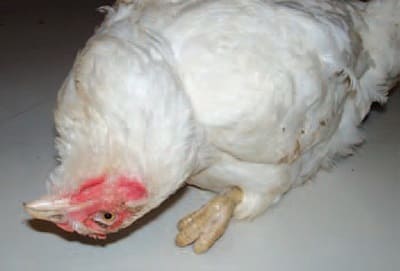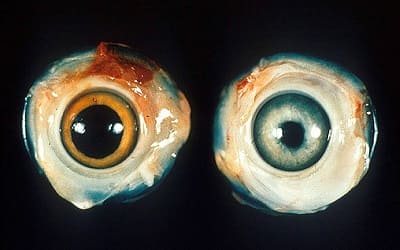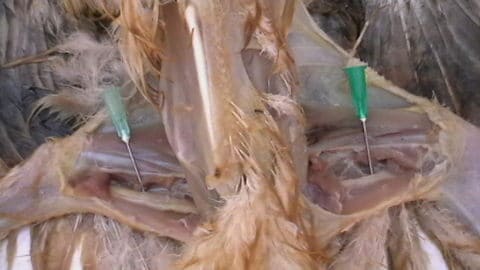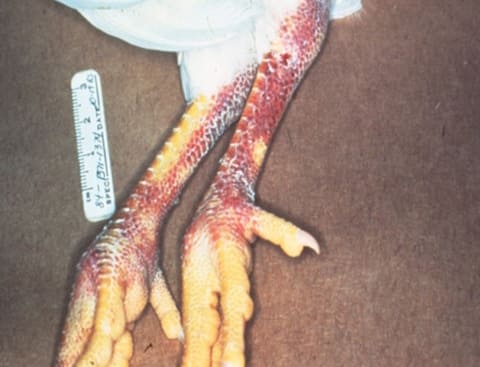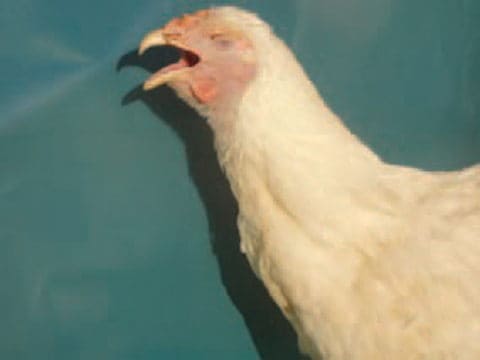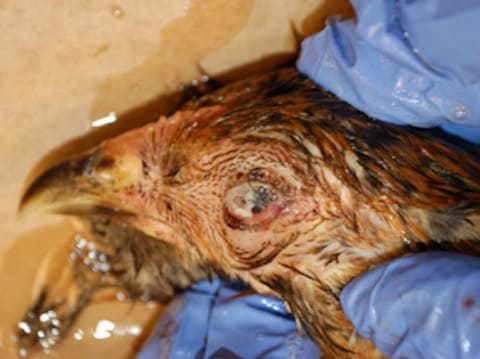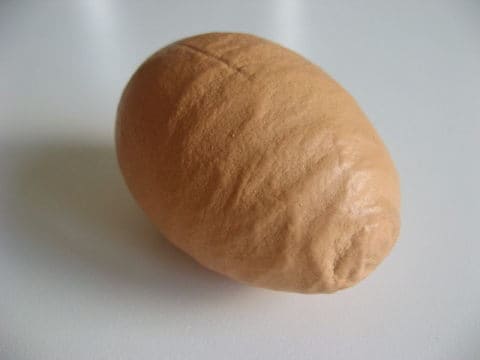For my own personal use only:
- Newcastle disease (avian
pneumoencephalitis)
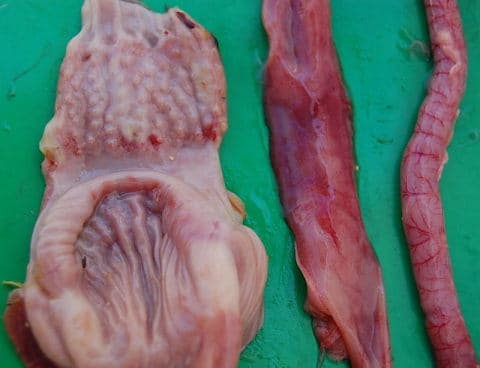
Petechiae in proventriculus and gizzard; inflammation of duodenum (outside & inside view), Newcastle disease - Classic case: high mortality rate
- Acute onset severe respiratory and/or neurologic and/or GI
signs:
- Respiratory:
- Gasping, sneezing, coughing
- Facial edema ("square head")
- Reddened lower eyelid (over lymphoid patch)
- Neurologic:
- Paralysis, tremors, droopy wings
- Torticollis, circling
- Bright and alert despite severe neurologic deficits
- GI: Watery green diarrhea
- Sometimes sudden death
- Decreased egg production with thin shells and watery albumen
- Acute onset severe respiratory and/or neurologic and/or GI
signs:
- Dx:
- Etiology: RNA avian paramyxovirus-1 (APV1 or PMV-1)
- Gold standard test: virus isolation
- Dead birds: lung, kidney, GI tract
- Live birds: nasopharyngeal and tracheal exudate swabs
- RT-PCR for pathotyping and genotyping
- Intracerebral pathogenicity index (ICPI): inoculating day-old chicks to determine virulence
- Hemagglutination positive
- Almost pathognomonic necropsy lesions: multifocal necrosis, hemorrhagic intestinal mucosa (especially at lymphoid foci - cecal tonsils)
- Rx: None, CULL all birds on premises
- Prevention:
- Good management practices, spreads quickly through facility via aerosol exposure
- Indoor operations better, outdoor flocks at higher risk
- Vaccines in countries where virulent virus disease outbreaks occur
- Prevention:
- Pearls:
- APV1 are labeled depending on how fast they kill chick
embryos post-innoculation
- Lentogenic (slow), used in vaccines and not reportable
- Mesogenic (medium)
- Velogenic (fast); further divided into:
- Viscerotropic (GI) velogenic Newcastle disease (VVND)
- Neurotropic (brain) velogenic Newcastle disease (NVND)
- Clinical signs vary with strain
- Strains vary by differences in surface glycoproteins: hemagglutinin-neurominidase (HN) and fusion (F)
- Mesogenic and velogenic Newcastle disease are REPORTABLE in USA
- ZOONOTIC: transitory conjunctivitis in humans
- APV1 are labeled depending on how fast they kill chick
embryos post-innoculation
- Classic case: high mortality rate
- Marek's disease
- Classic case: Clinical signs based on which
organ/tissue T-lymphocytes infiltrate
- Sciatic nerve paralysis (one leg forward, one backward)
- "Grey eye" (due to lymphocytic infiltration of iris)
- Young chicken (2-5 mos)
- Decreased growth rate and egg production
- Enlarged feather follicles (cause for condemnation)
- Dx:
- Etiology: Oncogenic lymphotrophic alphaherpesvirus (genus Mardivirus)
- Virus isolation, PCR (for viral DNA in lymphoid tumors), AGID
- Enlarged peripheral nerves (esp. sciatic) at necropsy
- Lymphoid tumors in liver, spleen, gonads, heart, lung, kidney, muscle and proventriculus
- Bursa is rarely affected and usually atrophic (distinguishes from lymphoid leukosis)
- Histopathology and immunohistochemistry
- Rx: None
- Supportive care in pet poultry
- Prophylaxis: vaccinate in ovo or day-old chicks decreases shedding
- Pearls:
- Virus causes in lymphoproliferative disease/neoplasia in chickens
- No vertical transmission; horizontal transmission is mainly via inhalation of aerosolized "chicken dander" & can travel on the wind between flocks
- Virus practically ubiquitous; assume flocks infected
- Silent recovered lifelong carriers are main reservoir
- Classic case: Clinical signs based on which
organ/tissue T-lymphocytes infiltrate
- Avian influenza (AI)
- Classic case: Depends on pathogenicity/strain
- Low-pathogenicity AI (LPAI): often subclinical
- Mild to moderate respiratory signs
- Poor weight gain
- Egg drop
- High-pathogenicity AI (HPAI): "Fowl plague"
- Peracute death, prostration
- Cyanosis of head appendages, petechiation in viscera, oral/nasal bloody discharge
- Diarrhea
- Neurologic signs
- Hemorrhages of the limbs
- Spreads rapidly!
- Low-pathogenicity AI (LPAI): often subclinical
- Dx:
- Etiology: Orthomyxovirus, influenza type A
- Virus isolation in eggs from clinical samples with rRT-PCR for typing
- Hemagglutination positive
- Haemagglutinin and Neuraminidase (H and N) typing and subtyping also done by inhibition tests using antisera (H5 & H7 HPAI subtypes are most commonly implicated)
- Rx:
- Prevention: autogenous vaccination (requires state veterinarian approval) and strict biosecurity
- HPAI: no treatment, depopulate
- Supportive care and antibiotics for LPAI
- Pearls:
- Highly contagious
- HPAI is REPORTABLE, possibly ZOONOTIC (H5N1, H7N7 can be fatal to humans)
- Often carried long distances by subclinically infected waterfowl or seabirds
- Gene re-assortment occurs in developing countries or markets where humans, fowl, and swine intermix, creating new genotypes
- Classic case: Depends on pathogenicity/strain
- Infectious
laryngotracheitis
- Classic case:
- Acute outbreak of gasping, coughing, conjunctivitis, dyspnea, depression
- +/- Bloodstained beaks in chickens under 4 weeks
- Decreased egg production
- Mortality variable, often high
- Chronic: poor weight gain in broilers
- Latent infection in survivors, can recrudesce when birds stressed
- Dx:
- Etiology: Gallid herpesvirus I
- Necropsy: blood, mucus, caseous exudate, or hollow cast in trachea
- Intranuclear inclusion bodies
- Clinical cases: virus isolation, PCR
- Screen flocks with ELISA or virus neutralization (VN) serological tests
- Rx:
- No treatment
- Immediately vaccinate adults during outbreak
- Prevent with biosecurity and vaccination
- Pearls:
- Highly contagious
- Worldwide; transmission horizontal through aerosol, fomites
- Vaccination with attenuated vaccines has regularly resulted in disease through serial virus passage in vaccinates
- Recovered birds are lifelong carriers
- REPORTABLE
- Classic case:
- Infectious bronchitis
- Classic case:
- YOUNGEST birds: acute onset upper (sneezing, conjunctivitis, swelling) and lower (rales, coughing, dyspnea) respiratory signs
- Breeders & layers: SHARP decrease in egg production and misshapen or wrinkled egg shells
- Variable mortality, but almost 100% morbidity
- Dx:
- Etiology: RNA coronavirus
- Necropsy: white urates in renal tubules
- NEGATIVE hemagglutination reaction
- Virus isolation in chick embryo
- Paired serology
- Rx: None, supportive care
- Antibiotics for secondary infections
- Prophylaxis:
- Vaccines
- Strict biosecurity
- Pearls:
- Worldwide, common, contagious
- Reportable in some states
- Some strains cause reproductive issues, some are nephrotrophic
- Classic case:
Images courtesy of The Poultry Site (torticollis/Newcastle, laryngotracheitis), USDA (grey eye/Marek's, avian influenza), Raketenpilot (walking chickens), Lucyin (Marek's sciatic nerves, Newcastle hemorrhages), Copyleft (wrinkled egg), Dr. Marina Brash (infectious bronchitis), Benjamint444 (silkie), and Dimus (turkey).
Top Topic Category
Poultry
